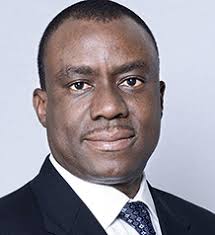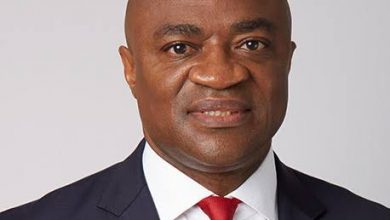STANBIC –IBTC:THE POWER OF STRETCH AND LEVERAGE

Driven by its capability to deliver better value for money , Stanbic commands the most expensive price for its stock in banking sub sector
For the shareholders of Stanbic –IBTC Bank , the financial year 2023 is well loaded with goodies and half way to its end , it is already a celebration galore for them .
This view may not be farfetched . For the better part of this year , the bank’s stock price was sky bond. As the major stock market indices returned positive in the first half of the year with major stocks gaining points year-to-date , Stanbic IBTC’s share price increased by 61% to close at ₦54.00 as of 30 June 2023. Stanbic IBTC share price recorded its highest point at ₦54.10 in the second quarter on 14 June 2023 and recorded its lowest point at ₦32.00 on 09 January 2023. . In fact , it outperformed the NGX All Share Index (ASI) which increased by 19%
It has not yet lost that steam .The current share price of Stanbic IBTC Holdings (STANBIC) is NGN 67.80. STANBIC closed its last trading day (Thursday, September 7, 2023) at 67.80 NGN per share on the Nigerian Stock Exchange (NGX).
Stanbic IBTC began the year with a share price of N33.45k and has since gained 103% on that price valuation, ranking it 34th on the NGX in terms of year-to-date performance. Shareholders can be optimistic about STANBIC knowing the stock has accrued 6% over the past four-week period—40th best on NGX. From the above scenario , its value investors have become millionaires overnight within the above space of time from the capital gain alone .Yet , it has declared N1.50k as its interim dividend.
The above scenario should not spring any surprise .Much of the bank’s northward share price movement, no doubt , was due to its inspiring showing last financial year which investors believed would repeat itself this current year
The bank did not disappoint. In first half of the current financial year , practically all its performance metrics looked up already at both the top and bottom line levels Its Gross earnings inched up by 58% to N213.33b from N134.87b; Profit before tax increased 100% to N82.99b from N39.98b ;ditto for its Profit after tax which swiftly hit N67.9b from N30.7b
Than anything the value per share of Stanbic-IBTC is what is raising question .More like a mystery ,today its price per share is the highest, the most expensive which no tier 1 bank is able to beat in the industry . When one digs deeper in the market , the signal from the investors is clear . The reason could be pinned down to the Stanbic Bank’s ability to deliver better value for money.
The above trend has already left investors craning to take another look at the bank’s performance. The bank’s performance is a harbinger of a juicier outing in the 2023 financial year.
The biggest and the only surprise is that the above feat was delivered amidst hostile macroeconomic environment.Nigeria’s GDP growth slowed to 2.51% year-on-year in the second quarter of 2023 from 3.54% year-on-year in Q2 2022 ,headline inflation increased from 21.34% in December 2022 to 22.79% in June 2023, maintaining an upward trend till date with a percentage growth of 1.45% year-to-date .Moreover , the Central Bank of Nigeria (CBN) Monetary Policy Committee (MPC) at its January 2023 meeting voted to raise the Monetary Policy Rate (MPR) by 100bps to 17.5%, culminating in 600bps (5 occasions) of rate hikes since May 2022. The committee further increased the MPR by 50bps to 18% in March 2023,another 50bps to 18.5% in May 2023 and the most recent to 18.75% in July 2023.
Then what is the secret behind this feat ? is it resources or profit that has given this bank’s stock an edge over the others in the market ?
Definitely no . Not in terms of financial resources .Its Total Asset H1 2023 is ₦4.45trn while its Equity for the H1 2023: ₦451b .Both are lower than half of what are at the disposal any tier 1 bank . In fact, it was even recently the above figures were jerked up by 47% and 11 % respectively . Even its H1 2023 profit after tax at ₦67.92b is far below the half of any profit deliver by some other bigger banks.
The above inclement environment notwithstanding it is not difficult to know the secret of a world-class entity like Stanbic . The feat registered by Stanbic Bank in the industry could be traced to its ability to respond to the competing pressures particularly the changes in macroeconomic environment , its strategic capability which comprises its resources and competences as well as its ability to meet the expectations created by the regulatory and governance framework , powerful stakeholders , ethical considerations and culture.
By its power of stretch and leverage Stanbic is making the difference . This bank has strong reputation, technological richness and deep pockets that enable it to hire the most talented people in the industry , to have sizable market shares and to have worldwide channels ..It is not only imagining the future be imagined ,armed with a credible strategic architecture or the map, it is building it ; it has proved beyond any doubt that the fuel for the journey is not money alone , but also the need for emotional and intellectual energy …
The bank from all indications is not in the race for size just for that sake alone . And this management position is confirmed by the fact that bigness without stretch and leverage is obesity, smallness without stretch and leverage is impotence.
In other words , Stanbic Bank is not after bigness for the bigness alone and its smaller size in terms of resources relative to some banks is not without better stretch and leverage .What drives this bank are what each of its stakeholders particularly value . Different stakeholders, ranging from the shareholdersc, depositors ,borrowers regulatorty authorities and the communities, particularly value different things .
For the shareholders of any organization , maximum or adequate returns on their investments are what they particularly valued in order to remain invested and to be willing to continue to provide additional resources and when needed .Stanbic Bank’s vision which is to be the leading end-to-end financial solutions provider in Nigeria through innovative and customer-focused people , is in line with this . And the bank ,no doubt , is doing it better than most players in the industry .
Stanbic bank is not only profitable but delivering better value for money . And what is powering this remains foresight, stretch, and leverage that provide the energy and rationale for proactive advantage building and industry re-engineering.
This claim is confirmed by certain performance indicators. The first manifests in the chain of returns the bank has been churning out year in year out . In the first half of the current financial year for instance , at a marginal level, the bank’s pretax profit margin took a leap to 39 percent from 30 percent, indicating a better and deep cut down of its cost of operation . Consequently the bank took more out of gross earnings in the first half of 2023 than it did in the equivalent period in 2022 as pre net profit margin jumped to N39 from every N100 as opposed to N30 made previously.
At the net -tax profit of this leading bank, the return shot up by 32percent in the period compared to 23percent in 2022
To cement its place as a highly profitable bank, return on equity (ROE), and return on assets (ROA), improved impressively to 32.5per cent and 3.9 per cent in 2023 from 15.7 per cent and 2.7 per cent respectively in 2022. These ratios made the choice of Stanbic Bank’s stock irresistible
The giant stride in profitability and attendant better value for money were what prompted investors’ positive perception of Stanbic Bank’s stock over years
.But the shareholders are not the only stakeholders satisfied by Stanbic Bank In managing the risks or business of financial intermediation , the core challenge in baking business ,apart from satisfying the shareholders ,every bank has to satisfy other four main constituencies. One is the surplus units from which it borrows ,the deficit units which borrow from the banks ,the regulatory authorities ,whose interest is to ensure that the bank does not undertake excessive risks and that it operates prudently and within stipulated regulatory requirements and the community at large. As the provider of the environment within which it operates .This bank perfectly lives up those expectations too.
Another constituency satisfied by Stanbic Bank is the surplus units from which it borrows . These units demand the best possible term in rates of interest and maturity structures and the maximum
liquidity to enable them to have the funds back when they want them , or as agreed . The marketing machine of the bank, it would seem is working overtime, growing deposits; that section of the bank’s balance sheet swung up 37.6 percent from N1.19b in 2022 to ₦1.64trin the first half of 2023
This was to be expected from a bank which ‘focuses and channels its resources only on its core corporate and retail banking activities’, activities which require steep marketing capabilities, and in a world where IT is ubiquitous, a firm understanding of delivering tech based services. The bank’s customer deposits between June 2022 and June 2023 grew by 37 per cent to N2.32trillion from N1.69trillion led by 59% increase in Term deposits at N317.38b from N199.46b,36.3% increase in savings at N216.59b from N158.94b,38% decline in Call deposits at N107.94b from N174b and 51.5% increase in Current accounts at N996.23b providing it with a platform to rebalance its deposits mix.
In June 2023, cheap deposits were foregone in favour of costlier deposits resulting in an increase of an expensive and shorter dated deposits . This culminated in the increase of cost of funds which grew by 40 per cent from 5.2 per cent in 2023 from 3.1 per cent in 2022 .
The results were a the need for the bank’s efforts to deepen its roots in the retail segment. The signal from the above scenario is for the bank to ensure a remarkable increase in the volume of transactions across various electronic platforms as well as significant customer acquisitions. This growth in transactions on the bank’s digital channels should continue to support the bank’s retail push
This bank also satisfies the deficit units which borrow from the banks . They want to borrow when they need the funds and as cheaply as possible .Like the lenders ,the borrowers also impose the obligation of maximum on the banks to enable them to obtain funds when they need them
As deposits grew, the bank could not restrict the comparatively faster pace of loans and advances, a key component of a bank’s maturity transformation tool.
The bank gave out loans and advances worth a hefty N1,66 trillion, 55.7 percent more than the previous year when N1.06 billion was applied.
The bank could take such a risk bristling from the confidence of a healthy balance sheet; after all its assets and shareholder funds can cover for any slips.The Bank assets which grew 41.4 percent from N3.15 trillion to N4.45trillion; shareholder funds grew 10 percent from N378 billion to N451billion
One observation is that the bigger this item on the balance sheet, the higher the interest income item on the income statement and then the higher the variability or the higher the credit risk.
How did these three items play out in the case of Stanbic Bank? Interest income shot up despite the escalating interest income while credit risk wings were clipped
The above has some implication on the fourth constituency that was equally satisfied by the bank in the period under review as the bank did not undertake excessive risks , operating prudently and within stipulated regulatory requirements . The bank’s balance sheet was robust as the loan to deposit ratio, liquidity ratio and capital adequacy ratios were 95per cent, 95.69% per cent and 18% per cent respectively, all well above the regulatory threshold .
CREDIT QUALITY
The bank’s non-performing loans ratio, however, decreased marginally to 2.3per cent in 2023 from 2.4 per cent in 2022.This is within the regulatory threshold and far below industry peers.
COST OF RISK
Also, the bank’s robust risk management framework ensured that the cost of risk reduced significantly from 1.1 per cent in the prior year to 0.9 per cent in 2023 . This was achieved through the reduction in impairment charges by 4.3per cent, N4.86billion compared to N5.08b in 2022 , re-affirming the bank’s enhanced asset quality. In the same breadth, coverage ratio was increased,an indication of prudent disposition consistent with the bank’s known rec ord of excellent credit risk management.
EFFICIENCY
As a result of the significant improvement in efficiency, the bank’s cost-to-income ratio settled at 48.1per cent from 59.9 per cent in 2022 .
A detailed analysis of the financial statement of the bank in the last six months of this year compared to the corresponding period last year revealed that the feat was made possible by the management’s ability to wrench up bottom line with a deft application of management’s experience beginning from leveraging net interest income. The Group’s gross earnings increased by 58.18%,
The bank grossed N213.33billion in earnings the half year under review, chalking a 14.5 percent gain from the N134.87billion achieved in 2022 .
Stanbic is able to navigate the banking terrain to get the results ,an insider says ,because it was ‘able to exploit the opportunities despite the fact that the ‘environment’ was fraught with plenty of hick ups in the current financial year
But by hauling up net interest income by 62% to ₦110.26 billion in H1 2023 from ₦68.25 billion achieved in H1 2022. , Stanbic Bank showed that it’s not the size of a bank’s earning assets but what you make out of it that matters. This was largely due to growth in interest earned on investment securities and loans and advances following growth in the volume of loans to its customers.
The first potential spoiler of the bank’s drive to deliver a better value for money was skyrocketing interest expenses which grew by over 100% to ₦37.57 billion in H1 2023, majorly due to growth in average term deposits and borrowings during the period under review.
Consequently, its net interest income increased by 44%, enabling an improvement in net interest margin to 4.3% compared to 3.5% in H1 2022 as asset yield hits 10.2% while its cost of funds moved to 3.2%
Though the battle against the interest rate was tougher than expected , the ability of the management to cage the credit risk battle rescued the bottom line further from the above spoiler . Credit impairment on financial assets was a charge of ₦5.98 billion in H1 2023, a marginal increase compared to ₦5.47 billion for same period in prior year. The impairment charge was due to the impact of expected credit loss (ECL) charges on new loans booked and additional provisioning on existing NPL’s. Although impairment on Stage 1 loans increased due to increase in new loans booked , however , credit loss ratio reduced to 0.9% in H1 202
The income from the Non Interest transactions also increased by 57% to N98.6b from N63b in 2022 driven by growth in both fees and commission income and trading revenue to boost the chances of delivering a better value for money to its stakeholders .
While its net fees and commission income increased marginally by 12.3% to N51.2b from N45.6b , the bank’s cost management wizardry displayed remains the joker that aborted the rooftop interest expenses that nearly caged its net interest income . The bank’s net fee income at N51.2b was secured at a cost of just 5% or N2.64b .The same feat was achieved in the corresponding of last year . The growth in net fees and commission is following a year-on-year growth in assets under management fees, fees earned from new loan bookings, and improved Investment Banking fees
However , the key game changer remained its fixed income and currencies that delivered N44.7b compared to N16.3b in the first half of 2022.The positive effect of the huge fixed income and currencies and cost maximization explained concerning its net fee and commission income had a dramatic effect on the turnaround of the bank’s bottom line .
The effect of this was palpable on its operating income which stood at N171.30b compared to N113.31b in 2022 relative to its operating expenses at N82.34b as against N67.87b .Operating expenses increased by 21% year-on-year as its operating income increased by 51%.
Its faster growing operating income compared to expenses, led to an improved cost-to-income ratio of 48.1% compared to 53.9% recorded in FY 2022.
This increase in the operating expenses was due to the impact of currency depreciation and subsidy removal leading to increased training expenses, information technology, communication, premises and maintenance costs as well as energy costs.Regulatory induced charges such as AMCON levy and deposit insurance premium also increased which is attributable to the growth in balance sheet size.
The last line that contributed to its impressive bottom line was the effective tax rate declined to 18.2% from 23.3% in H1 2023 due to lower assessable profit for the period ended June 2023




